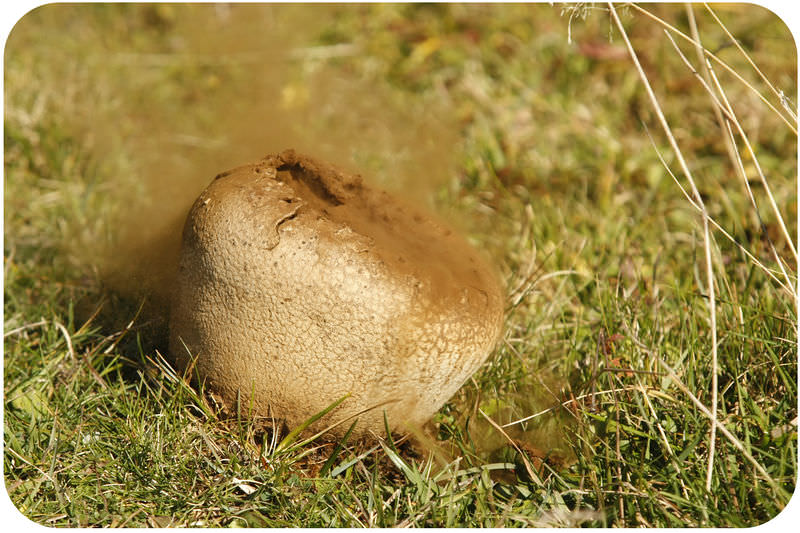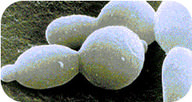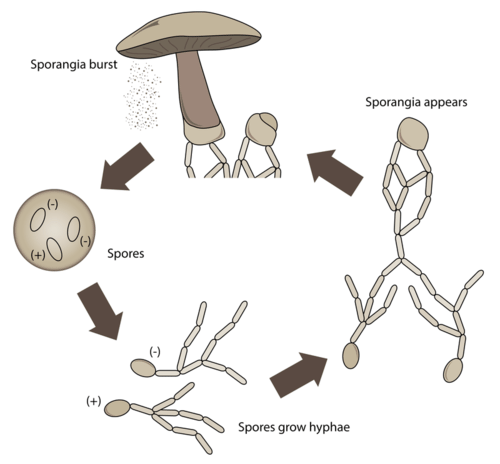6.9: Fungi Reproduction
- Page ID
- 13748

What's this brown powder coming out of the fungus?
This is a "puffball" fungus. At maturity, clouds of a brown dust-like power escape when they are touched. This powdery substance is made up of spores, the reproductive structure of the fungus.
Reproduction in Fungi
Different fungi reproduce in different ways. Many fungi reproduce both sexually and asexually. However, some reproduce only sexually and some only asexually. Asexual reproduction involves just one parent and sexual reproduction involves two parents.
Asexual Reproduction
Through asexual reproduction, new organisms are produced that are genetically identical to the parent. That is, they have exactly the same DNA. Fungi reproduce asexually through three methods:
- Spores: Spores are formed by the fungi and released to create new fungi. This is the powdery substance released by puffballs. Spores are haploid reproductive cells found in some bacteria, plants, algae, fungi, and protozoa. Theoretically, spores can reproduce asexually to produce countless offspring. Obviously this does not happen. If it did, the world would be covered by genetically identical fungi.
- Budding: The fungus grows a new part of its body, which eventually breaks off. The broken-off piece becomes a “new” organism (Figure below).
- Fragmentation: In this method, a piece of the mycelium, the body of the fungus, splits off. The resulting fragment can eventually produce a new colony of fungi.

Asexual reproduction is faster and produces more fungi than sexual reproduction. This form of reproduction is controlled by many different factors. Outside conditions, such as the availability of food, determine when a fungus undergoes asexual reproduction.
Sexual Reproduction
Almost all fungi can reproduce sexually. But why reproduce sexually when asexual reproduction is much quicker? Sexual reproduction brings together traits from the two parents. This increases the genetic diversity of the species. In plants and animals, sexual reproduction occurs when sperm and egg from two parents join to make a new individual. In fungi, however, two haploid hyphae meet together and their nuclei fuse. Instead of calling a hyphae male or female, they have different mating types, such as (+) and (-) (Figure below).

Summary
- Fungi can reproduce asexually by spores, budding, or fragmentation.
- Fungi can reproduce sexually to create a zygospore.
Explore More
Use the resources below to answer the questions that follow.
Explore More I
- Reproduction in Fungi at http://www.youtube.com/watch?v=qDwgSWDqKoQ (2:06)
- Where are spores made in a fungi?
- When does fertilization occur in fungi?
- When does meiosis occur during the reproduction cycle of a fungus?
- What disperses the fungal spores?
- What happens to the spores in favorable conditions?
Explore More II
- Sexual and Asexual Reproduction in Fungi at http://www.youtube.com/watch?v=A1uQ5rXmbO8 (2:33)
- When is asexual reproduction advantageous to fungi?
- When is sexual reproduction advantageous to fungi?
- How does the ability to reproduce sexually or asexually make fungi adaptive to a wider range of environments?
Review
- How do fungi reproduce asexually?
- What is the advantage of sexual reproduction?
- What is a spore?
- What are the two "sexes" of fungi?

